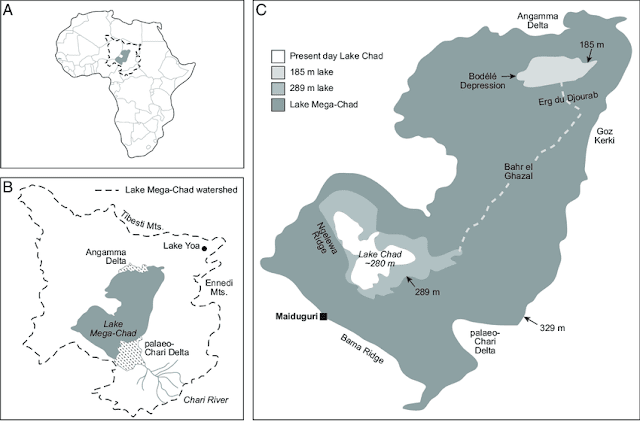Lake Chad and Lake Victoria
'Lake Chad offers a grim cautionary tale of how lessons from chronic drought might inform our anticipation of the potential impact of climate change in many parts of Africa' (Juma 2017).
This quote reflects part of my motivation behind this blog. I chose to focus on Lake Chad as an example of the potential consequences of climate change on the African environment. This article in Quartz Africa goes on to suggest that Lake Victoria in East Africa is vulnerable to the same dramatic environmental change.
Figure 1: Lake Victoria within it's basin, market by the black line.
Source: NASA Earth Observatory
Lake Victoria is Africa's largest lake, the world's largest tropical lake and second largest freshwater lake. For comparison, Lake Chad was once the 6th largest lake in the world (Seipel 2006). Lake Victoria's basin (Figure 1) is small relative to the size of the lake and the majority of water input into the lake comes from rainfall directly onto the lake (NASA Earth Observatory). Therefore, small changes in climate can lead to large fluctuations in lake level. Lake Victoria's water level fell by 1m in 10 years (data from 2005) and being the source of the White Nile, this has had and will continue to have major impacts on populations reliant on the lake's waters and the White Nile (Selva 2005).
Figure 2: Deforestation of the Logoman Forest, Kenya at the edge of Lake Victoria.
Source: Daily Nation
The main cause of rapidly falling water level in Lake Chad has been abstraction for irrigation. On the other hand, Lake Victoria is faced with different problems. Deforestation in the basin close to the lake has reduced the efficiency of the catchment (Figure 2), in addition there has been evidence of overfishing and invasive species as well as pollution of the lake's waters (Seipel 2006). The fishing industry in Lake Victoria is thought to be worth $400 million per year. If the decline in fishing which has been seen in the Lake Chad is mirrored in Lake Victoria, this could have major implications for economies which rely on the fishing industry. Lake Victoria supports 200,000 fishermen as one of the largest inland fisheries in the world (Marshall et al. 2013). As well as overexploitation, eutrophication is a major concern for fishing stocks in Lake Victoria. Nile Perch are thought to be very sensitive to low oxygen conditions in the Lakes deep waters. This seasonal deoxygenation is a result of eutrophication. Although, there is debate over the extent of the sensitivity of Nile Perch to oxygen concentration, there is no doubt that eutrophication can have devastating effects on a lake's ecosystem.
Other African Lakes which have been affected by environmental change include Lake Tanganyika which I have mentioned in a previous blog post. Lake Tanganyika's lake level fell by more than 5 feet in 5 years. Additionally. Lake Turkana in northern Kenya has experienced a reduction in inflow by over half. Extreme environmental change in African lakes is not exclusive to Lake Chad, the changes are widespread but spatially variable.
Other African Lakes which have been affected by environmental change include Lake Tanganyika which I have mentioned in a previous blog post. Lake Tanganyika's lake level fell by more than 5 feet in 5 years. Additionally. Lake Turkana in northern Kenya has experienced a reduction in inflow by over half. Extreme environmental change in African lakes is not exclusive to Lake Chad, the changes are widespread but spatially variable.




There is a review of recent changes in the level of Lake Victoria in response to exccessive dam releases here: https://www.hydrol-earth-syst-sci.net/21/4533/2017/hess-21-4533-2017.pdf. Maybe review for a future blog post?
ReplyDeleteI'll take a look at that!
Delete